DAIRY and BEEF CATTLE
1/109
There's no tags or description
Looks like no tags are added yet.
Name | Mastery | Learn | Test | Matching | Spaced |
|---|
No study sessions yet.
110 Terms
Calf
young bovine; typically less than 1 year old
Bull
Sexually mature male (intact)
Cow
sexually mature female (has had calves)
Heifer
female that has not had a calf, generally are less than 3 years of age
Springer
female that is close to calving
Steers
castrated male
Gomer Bulls
vasectomized male
Calving
The process of giving birth in cattle
35,000
How many US dairy farms producing milk in the US
7.4 gallons
the average US cow will produce this much milk per day
Holstein - Friesiat
the most popular dairy breed in the US
Little development in the dairy industry before 1856
Reason 1 is that most families had a personal cow they milked and often used for meat as well. 2 there was no long-term storage
Condensed Milk
Water removed (about 60%), sugar added, canned
Louis Pasteur
discovered the process of pasteurization
heat the milk - HIGH TEMP SHORT TIME
Why we care about fat content
Producers: to know how much to charge
Consumers: specific fat —> 0% - 3%
Ayrshire
Came to US from Scotland and come in variety of red and/or white colors. Weigh about 1200lbs when mature. Known for ease of calving
Ayrshire
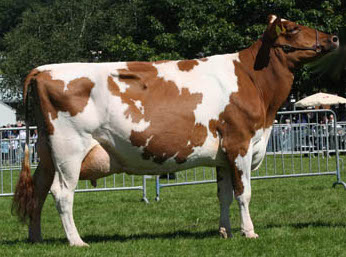
Brown Swiss
Came from the Alps in Switzerland and are solid brown but the color varies. Weigh about 1500lbs when mature. Known for longer gestation (about 1-2 weeks longer than other dairy breeds), producing higher fat milk (good for cheese), gentle temperament, and hardy
Brown Swiss
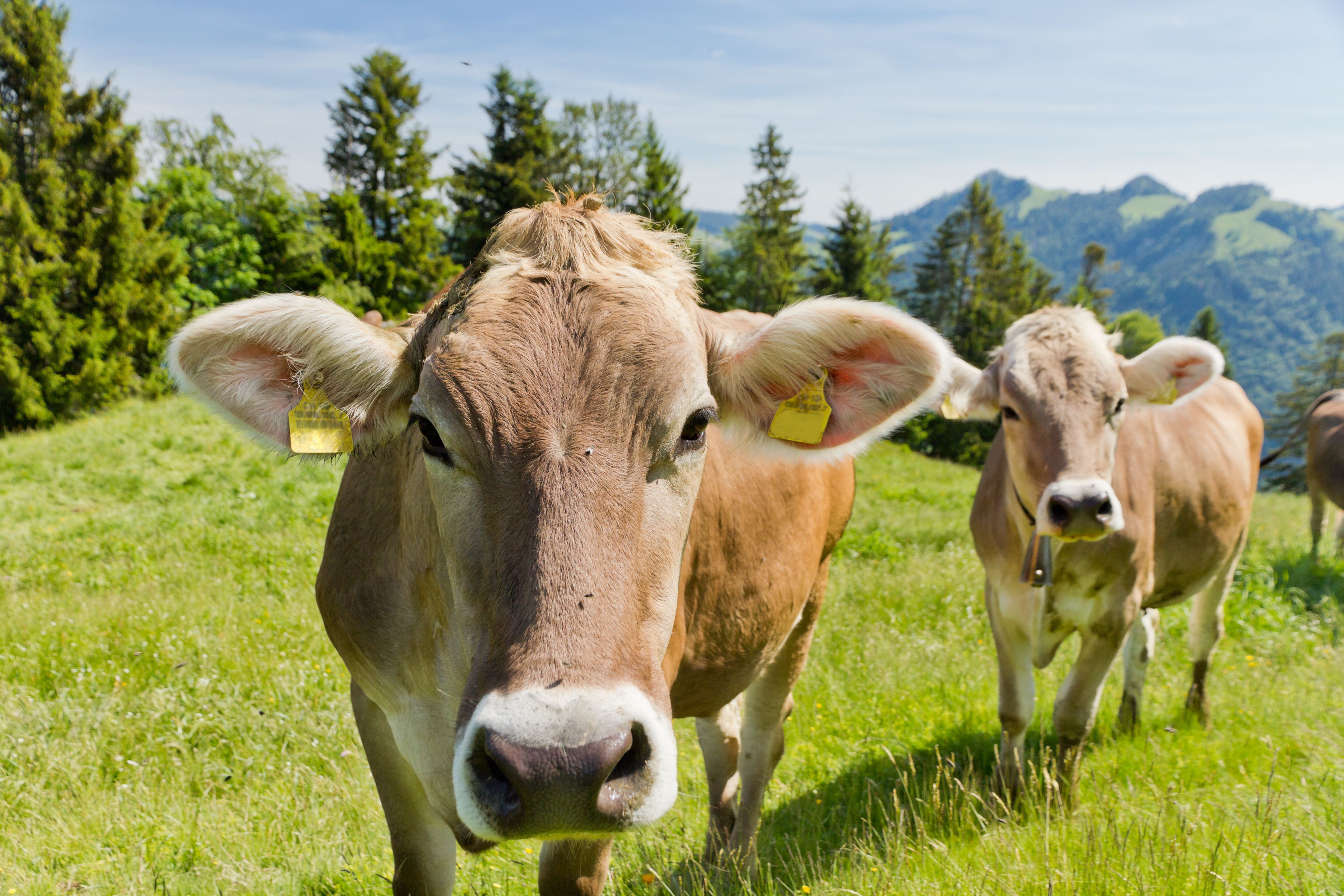
Guernsey
First derived from the British Channel Island of “ ___ “ (off coast of France) and came in a fawn to brown color with white patches. Weigh about 1000lbs when mature. Known for being excellent feed to milk converters (consume 20-30% less feed than other dairy breeds) but still have higher fat content. Also known for producing a golden color milk (beta carotene binds to fat)
Guernsey

Jersey
Originally produced on an island off the coast of Normandy, France and has a fawn coat color. Generally weigh less than 1,000lbs when mature. Known for smaller body, calving ease, and for the fact that they do well in extreme heat
Jersey
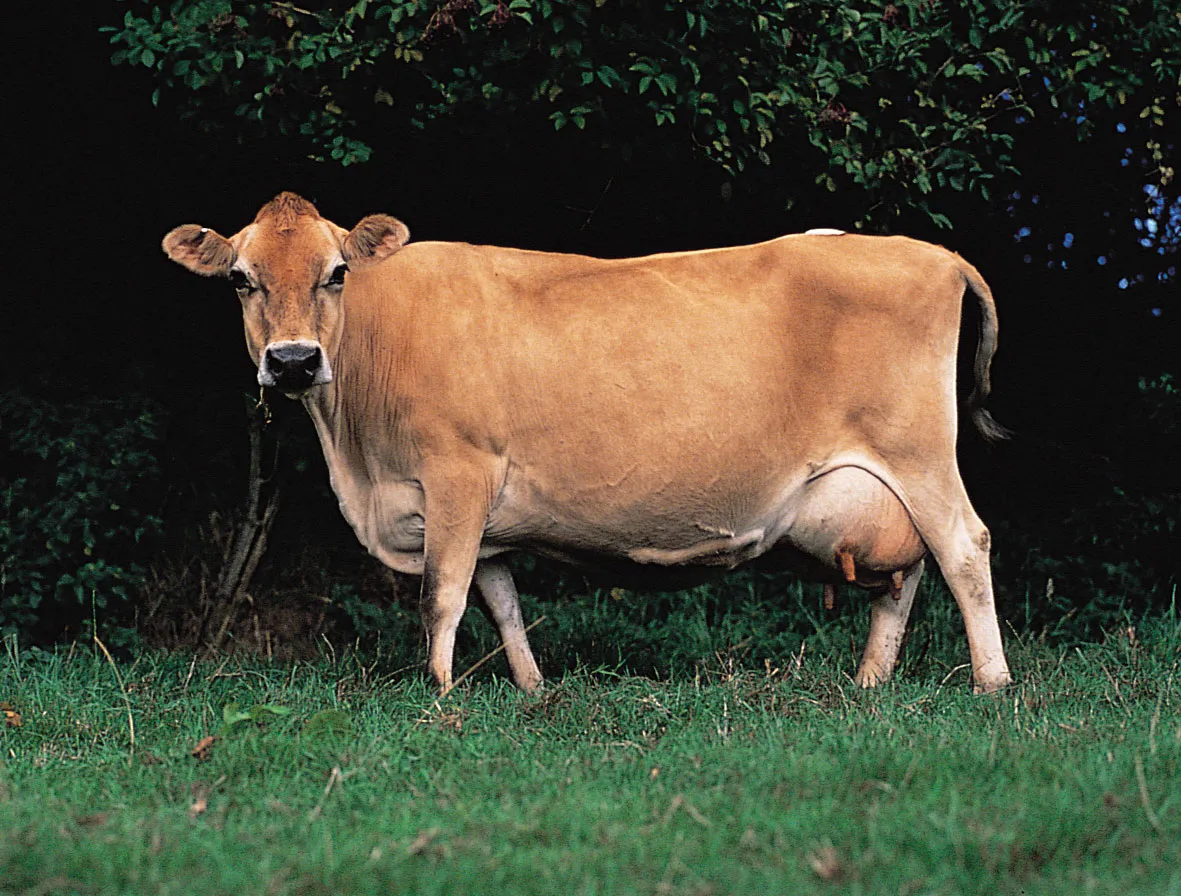
Shorthorn
Originated in England and are red, white, or roan. Weigh about 1300lbs when mature. Known for being both a beef and dairy breed
Shorthorn
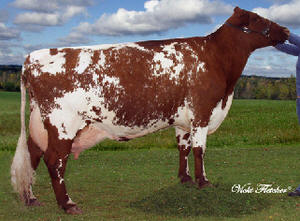
Holstein
The black cattle of the Batavians and white cows of Friesians (today is an area in Germany) were bred and strictly culled to produce animals that were the most efficient, producing the most milk with minited feed resources. These animals genetically evolved into the efficient, high producing black-and-white dairy cow known as the Holstein-Friesian, but we shorten it to just “___”. Weigh about 1500lbs when mature. Known for high milk production
Holstein
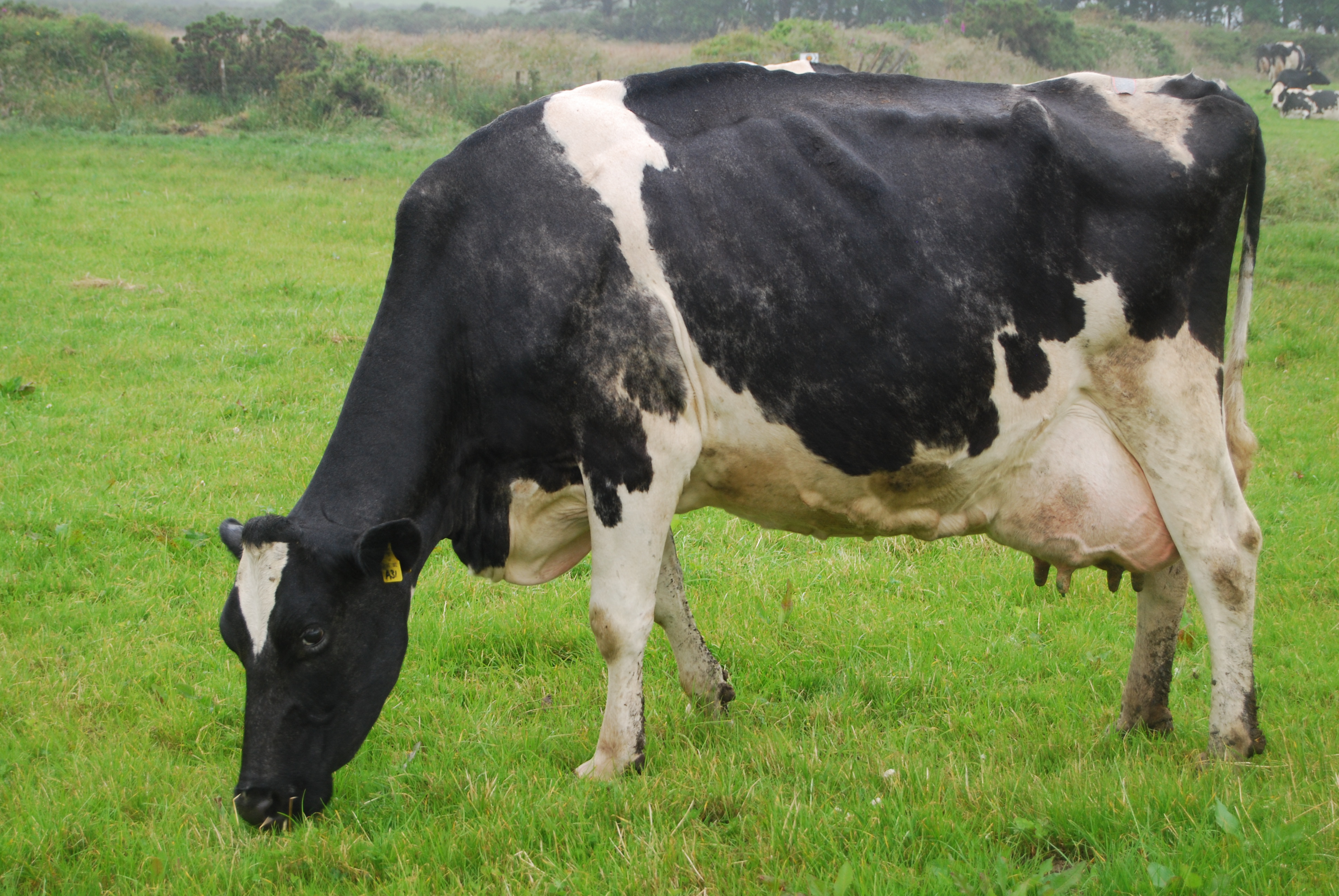
60%
when cows are comfortable they will spend “___” of their time laying down
20-50%
Research has demonstrated a “____” increase in blood flow to the udder in cows lying down vs. standing
about 500 gallons of blood flow
equals 1 gallon of milk
Intensive system
this setting wants to MAXIMIZE milk yields; rations high in concentrations (most diary settings in US are this system)
Intensive system includes
Tie stalls
Free stalls
Compost bedded pack
Grazing based system
Strive to OPTIMIZE rather than maximize milk production
More pasture-based with additional concentrates as opposed to high concentrates
IMportant that grazing costs are low because milk production will be lower compared to an intensive setting
Grazing based system advantages and disadvantages
Advantages:
less maintenance/cleaning
more opportunity to move
decreased feed cost because they are grazing more
Disadvantages:
less milk production
Bedding should provide
1) Comfort for cows (encourage them to be down)
2) Provide traction (when getting up/down)
3) Cleanliness for cows
4) Cost of bedding
5) provides ease for workers
Compost (wood shavings, sawdust:
12-18 initially spread in barn, manure build up gradually
top 8-12inches needs to be aerated 1-2x/week (clean out rear of stall 2x/day)
small amounts are added as needed weekly
1-3x/year, all bedding removed and spread on crop fields
Geotextile mattresses
Come in a variety of materials and are filled with rubber crumbs, foam, or water
Installed and then can be cleaned/removed as needed
Sand
Generally bed stalls at 8-12 inches deep
Mammary gland
an excretory organ that uses a duct to secrete a substance to the outside of the body
Endocrine glands
are ductless and excrete substances internally (usually into the blood stream)
The udder of a cow
1) 4 independent glands; each one has a duct/teat
2) right/left side separated by medial suspensory ligament (MSL)
3) Forequarters 40-45%
4) Hindquarters 55-60%
Causes increase oxytocin secretion
1) Calf stimulation
touch - udders
sound - Bawling
2) People
touch
How milk is produced
1) Blood supply (from artery) provides nutrients/oxygen to epithelial cells
2) Epithelial cells actually produce milk
3) Hormone oxytocin allows for muscle contraction
4) Milk moves toward teat
Oxytocin
Produced by the hypothalamus
Secreted by posterior pituitary
important for milk let down
Bullock
young, sexually intact male; will be slaughtered at 1-2 years of age
Stag
bull castrated after reaching sexual maturity
4 major sectors
1) cow-calf operation
2) stockers/backgrounders/growers
3) feedlot
4) seedstock producer
Cow/calf producer
Animals produced primarily for meat
Segment results in a 5-10 month old animal
Wean at 6-7 months of age
Often are crossbred animals
Will have spring and/or fall calving season
Stocker
Grow frame (no interested in marbling) on animals prior to finishing at a feedlot
Animals usually 6-9 months of age while here
Often use low-cost forages (crop residues) to feed; can be on a dry lot
Feedlot
Finishing cattle for slaughter; interested in marbling/grades/and weight
Animals fed heavier concentrates to increase marbling
Beef cattle finished about 1,100-1,400lbs
Concentrates
grain products; higher in energy, lower in fiber (corn, wheat, soybeans)
Forages
Higher in fiber, lower in energy (grass, hay, haylage)
how often cows are milked
2-3times per day (typically morning and evening)
Herring bone
its a term used to describe the slanted way the cows are aligned to the milking units. (16 cows can be milked at one time)
Cows ankle ID pedometers
Like a ankle bracelets that allow us to keep track of their movement and milking’s.
Reduces the spread of various mammary infections in dairy cows
workers were clean gloves while they are prepping cows before and after milking
Remove any large debris
the cows will be brought into the milking parlor and will have any large debris (like bedding/sand/mud/manure) removed from their udder area; prevents unwanted particles getting getting into milking system
Teat forestripping
handlers will strip each teat from top to bottom of milk present.
1) this allows us to determine whether there is any visually-detectable infection in the udder/teat
2) Also stimulates oxytocin (hormone produced/released by the posterior pituitary in brain) and causes milk letdown
Teat pre-dipping
handlers dunk at least 75% of each teat in a germicidal substance (often an iodine product) and allow it to sit on the teats for at least 20-30 seconds. This is done to reduce the microorganism content in the bulk tank.
Teat wiping
after the designated time, each teat much be wiped to remove the germicidal liquid and dry the tissue before unit attachment. Wipes can be disposable wipes or re-usable (bleached) clothes
Unit attachment
should be applied to teats that are clean, dry, and ‘milk ballooned’ (or full). Units should be placed straight and balanced (otherwise air can enter or the suction simply won’t start). Milking should begin immediately and last around 4-5 minutes
Teat post-dipping
Handlers will dunk at least 75% of each teat in a thicker germicidal substance that will stay on the teat. After milking, part of the teat will remain open for about 15-20 minutes, so we want to reduce the chance that cows lay down within that time range after milking. This reduces that chance that microorganisms could get access to the inside of the teat/udder and cause an infection.
Mastitis
An inflammatory response of the mammary tissue typically due to bacterial infection (which can be spread), but can also be caused by trauma.
SYMPTOMS: milk smells/ discolored, mammary tissue inflamed/redness, not wanting to lie down
2 common ways cows can become infected with bacteria that causes mastitis
1) Transmitted from infected cow to uninfected cow (via fomites like dirty milking units, handlers not changing gloves, etc)
2) Transmitted to uninfected cow via her environment; dirty bedding, feces, moist conditions, etc
Why we want to prevent mastitis in dairy cows
1) Very painful for the cows and its very uncomfortable
2) Milk cannot be used for human consumption due to microbial residues. Additionally, when cows are being treated for mastitis, milk cannot be used for human consumption
3) It costs producers money each time a cow gets mastitis and must be treated; can be $300 to treat a single cow for mastitis. The US along loses $1 billion due to mastitis each year
Calf Behavior
Normal: Moving away from or towards people when approached; might be sleeping but should respond when handlers appear
Abnormal: Not finishing feed; appear less inquisitive or weak; teeth grinding
Eyes assessment
Normal: clear, bright
Abnormal: cloudy eyes or containing any surrounding cloudy discharge; sunken eyes
Ears assessment
Normal: alert and mobile (flicking around as calf listens)
Abnormal: limp or drooping
Nasal discharge assessment
Normal: might appear moist
Abnormal: colored discharge
Umbilical Stump assessment
Normal: dries up around 24 hours of age
Abnormal: moist, painful, warm, bloody or have any discharge
Calf Assessment: Feces check
Normal: little or no feces present on hair of hindquarters; manure should be yellow to brownish in color and sticking together and sticking to bedding
Abnormal: feces coating tail/hind legs; watery manure or blood - tinged manure that slips through bedding; diarrhea=scours
Calf Heart rate
Normal range is 100-140 beats per mintues
Calf Respiratory rate (RR)
Normal range is 30-60 breaths per minute
Calf Skin tenting on neck
Done to test dehydration
Normal: less than 2 seconds to return to normal
Temperature assessment
Normal range is 100.0-102.5 degrees F
Immediately after calf is born
1) Remove any part of the placenta from around the face of the calf so it can breathe
2) Check for breathing. If not, stimulate breathing by tickling the nostrils with straw and vigorously rubbing the calf
3) Calf warming up ( the legs and nose should be drying and warming). It is normal to see a newborn calf shiver, but this should stop after the calf is dried
4) Dunk the umbilical stump in a germicidal solution
5) The calf receives about 8% of its body weight in high-quality colostrum within a few hours of birth (about 3-4L)
EPDs
Means expected progeny difference which provides expectation for birth weight, weaning weight, yearling weight, and marbling score. (based off Bull)
Purebred
specific behavioral/physical characteristics over and over
Hybrid vigor
Advantage for crossbred animals
Means offspring out-performs sire and dam for specific behavior/physical characteristics (ex. Body weight, marbling, speed, height)
Bos Indicus
From India
leaner and tougher meat
hump of back
later maturity
fattier milk; lower yield
more + larger sweat glands; tolerate hot climates
narrow and more angular hips
Bos Taurus
From Europe
More marbling and better meat quality
no hump
earlier maturity
Larger yield but not as fatty milk
less and smaller sweat glands; better in temperate climates
wider and more square hip bones
Angus
Scottish
Naturally polled (no horns) and either solid black or red
#1 breed in US
excellent marbling, good mothers, dystocia issues ( problems giving birth), heat stress
Cows = 1200lbs Bulls = 1800lbs
Angus
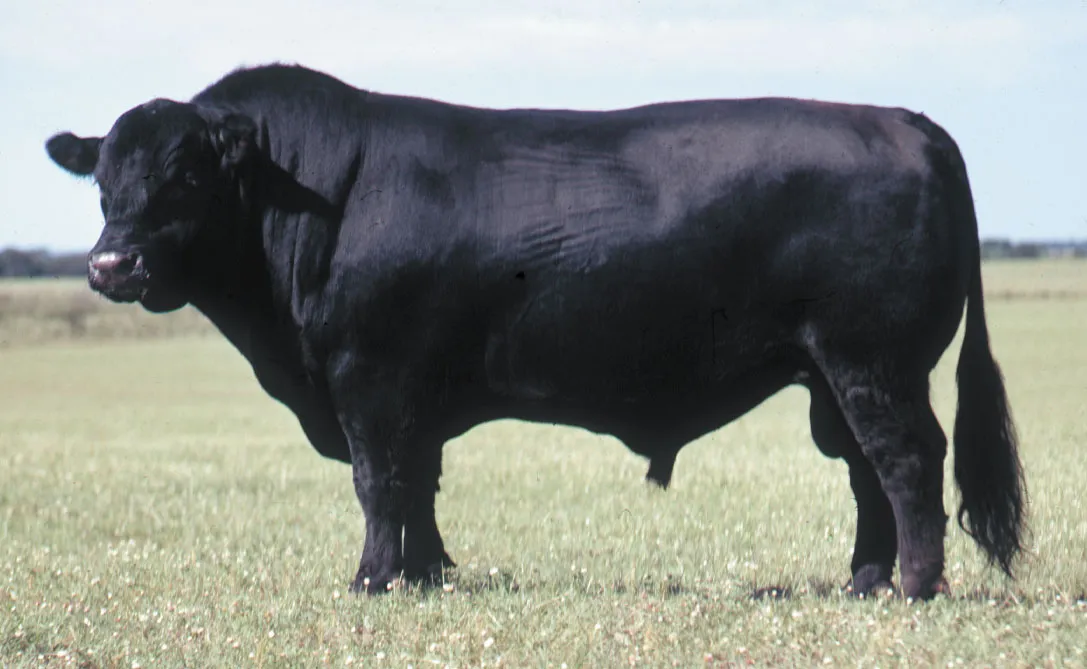
Hereford
British breed
Polled variant since late 1800s
Foraging ability + longevity, increase risk of eye issues, hereditary vaginal prolapse
Cows = 1700lbs Bulls = 2000lbs
Hereford
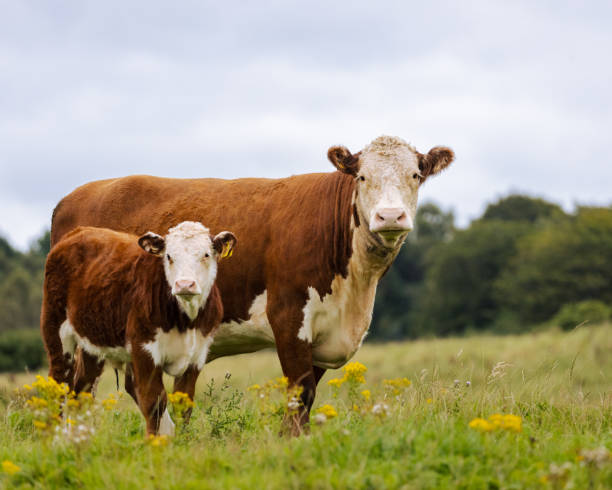
Belted Galloway
Scottish breed
Double Coat (curly H2O resistant outercoat + fluffy undercoat)
Quiet temperament, good mothers, mature slowly (don’t breed until +2 years old)
Cows = 1200lbs Bulls = 1800lbs
Belted Galloway

Simmental
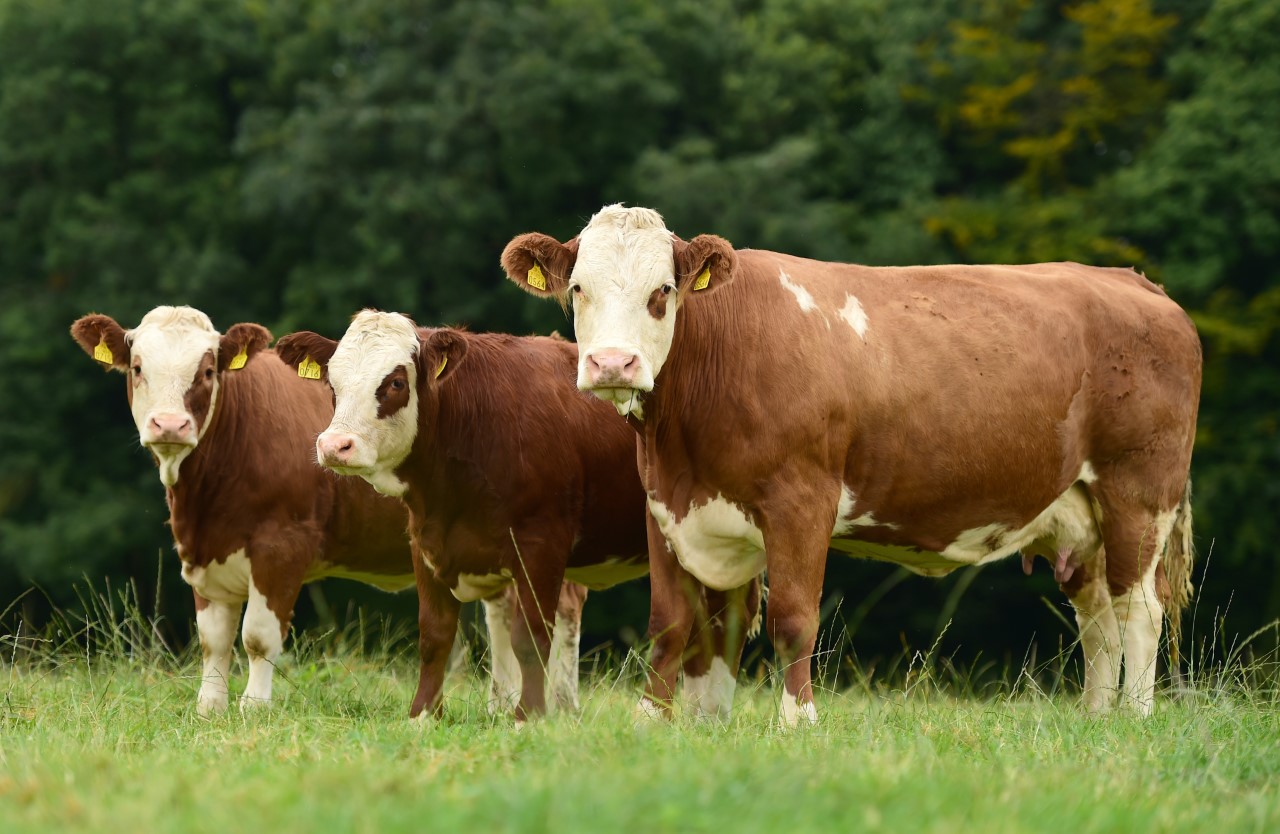
Charolais

Brahman
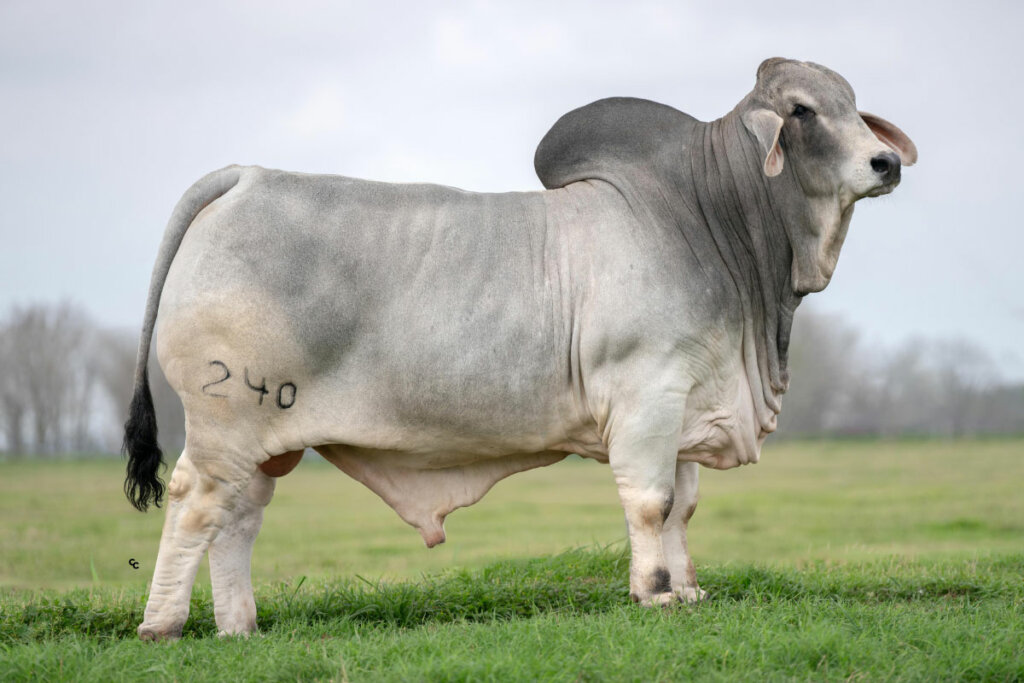
Simmental
Swiss breed
Notice the colored hair around eyes
easy calving, meat quality, milk producers for calves, increase mastitis
Cows = 1900lbs Bulls = 2800lbs
Charolais
French breed
All white/cream
Efficient feedlot gains, meat quality, slower to mature, poor temperament
Cows = 2000lbs Bulls = 2200lbs
Brahman
Bos Indicus breed
Hump on back, loose skin
Small calves
Often used to cross with Bos taurus breed (advantage is for greater heat tolerance)
Bovine Viral Diarrhea (BVD or BVDV)
A) Causes early embryonic death/abortion, and fetal malformations if cow infected before day 40
B) If a cow is infected from day 40 -120, she will have a persistently infected calf or PI calf.
(LOOK AT NOTES)
How BVD gets into herd
replacement animals (from auction)
No quarantine time
Not having strong vaccine program against BVDV
Contaminated semen
Screwworm
(New World screwworm); found in Western Hemisphere (mainly South America and Central America) Enter wounds/body orifices andfeed on live tissue.
Screwworm life cycle
1) Female mates with male ONLY once
2) Female attracted to warm blooded animal; eggs laid in wound/mucus membrane; Hatch
3) Larva feed for 5-7 days
4) Drop off animal and burrow into soil (2-60 days)
5) Adults emerges; can fly over 125 miles
How to control the population of blow flies
Sterile Insect Techniques (SIT)
male flies are mass-reared and then exposed to gamma rays (irradiation) that damages chromosomes in sperm (infertile)!
Release sterile males “breeds” female but she can’t actually lay fertilized eggs
Liquid Nitrogen tank
store semen in
Ob chain + handle
wrap around calf’s legs to help pull a stuck calf